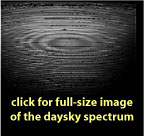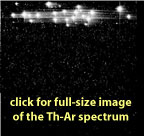Navigating the Spectrum
Vertical Positioning | Horizontal Positioning | Using Day Sky | Using Th-Ar | Rotation | Previous Thorium-Argon Spectra
If you took a successful day-sky or Thorium-Argon test exposure, you can use it to judge the current position of the spectrum on the CCD, and decide if and how much you need to adjust it. If you haven't already made a test exposure, now would be a good time to do so (bearing in mind that for purposes of positioning the spectrum, a day-sky exposure is easier to find your way around in, but if you need positioning precision of a few pixels, Th-Ar is the better bet.)
The exposure(s) you use for positioning need to be roughly in focus, especially if you're aiming for precise positioning. A preliminary focus by eye is will do; rigorous focusing should not be attempted until the spectrum is at least close to the position at which you plan to observe. So, if your spectrum looks fuzzy, change "Dewar Focus" in hammotor_gui by at least 10 steps (50 microns) and take a new exposure. Iterate until satisfied. (Hint: You only need to see a few lines to get a good eyeball focus, so you can save readout time by making the CCD window smaller.) The 2048x2048 CCD's in use with the Hamilton capture virtually the entire useful spectrum produced by the instrument in a single exposure (the 4096x4096 CCD in dewar 4 does capture the entire useful spectrum). However, there is no single setting used by all observers. Particular program requirements may call for particular positioning. E.g., programs that entail many short exposures may wish to trade bandpass for shortened CCD readout times by positioning the spectrum so that only the bandpass of greatest interest is read out, or a program that is especially concerned with a few particular spectral lines, may wish to adjust the positioning to ensure that none of these features falls on a CCD defect (our chips, are in fact, cosmetically excellent, but some low-level defects may be present). The position of the spectrum is not set in advance by the mountain staff, and must always be checked at the beginning of a run, even if you are directly following another observer who used the same detector. Even if you are confident that the setup you are inheriting from the previous observer is suited to your observations -- e.g., you are observing on the same program -- you should check the position. The position may be checked using either daylight (weather permitting) or the Thorium-Argon lamp. The former is in some respects easier, but the latter is better if you are aiming for a very precise positioning -- e.g., to exactly reproduce a setting from an earlier run -- because narrow emission lines can be more accurately pinpointed than the broader solar features.Vertical Positioning
hammotor's "Dewar Height" stage moves the spectrum up or down on the CCD. The height value does not have any absolute physical significance (the numbers represent stepper-motor units), but the number of pixels moved is related to it by a constant, equal to 8.97 motor units per pixel for dewars 6 and 8 (7.18 motor steps/pixel for dewar 4). A larger height value moves the spectrum up on the CCD. E.g., to move the spectrum up on the detector by about 100 rows (pixels), hammotor's height value should be changed by about +897 units for dewar 6 or 8. (Note the constant is not perfect, and that another iteration or two may be needed for fine adjustment.)Horizontal Positioning
hammotor's "Grating Tilt" function moves the spectrum left or right on the CCD. As with "Dewar Height," grating values are related to pixels by a constant; in this case equal to about 1.15 units per pixel for dewars 6 and 8 (0.92 units/pixel for dewar 4). Larger grating values moves the spectrum to higher-numbered columns. Again, a couple of iterations may be necessary to obtain a precise position. Whether using day sky or Th-Ar, start by identifying a line or two, then, by counting orders above and below the known feature(s), and using the Table of Orders, you should be able to determine the current wavelength coverage. For most purposes, placement of the red orders with respect to the first row (at top in our illustration) is the primary consideration, because even if the redmost orders in the Hamilton's useful range are placed on the first rows of the CCD, the bluemost orders will be included.Checking Position Using the Day Sky
The solar spectrum has clear, easily recognizable features that make it ideal for determining the wavelength coverage with the currrent spectrograph settings. (It's also really beautiful to look at!) Weather permitting, the Coudé Auxiliary Telescope (CAT) is used to provide day sky illumination, but the CAT need only be partly opened for this purpose. Opening the CAT for day-sky illumination is described in the CAT manual. Remember that weather conditions must be within observing limits to open the CAT, even for the purpose of making a day-sky exposure. On a sunny day, an exposure of 3-5 seconds, with a typical observing aperture (e.g., 640-microns) will produce a good exposure. In cloudy weather or late in the day, longer exposures may be necessary. Your day-sky exposure should look similar to the one illustrated above. Follow the directions for vertical and horizontal positioning, above, to make adjustments.Checking Position Using the Thorium-Argon Lamp
The performance and output of calibration lamps varies. Over the life-cycle of a particular lamp, intensities (e.g. of spectral lines) may decrease or increase with time until one, or more, of the constituents of the lamp ultimately decays. Decay can occur over a noticeable time interval or may be instantaneous. In the event of the decay of an existing calibration lamp, attempts shall be made to install a like-for-like replacement from stock spares, sufficient to generate spectra which can provide overall calibrations consistent with the preceding lamp. However, design, suppliers and costs of replacement lamps evolve. There is no guarantee that replacement calibration lamps shall be identical to their predecessors. Replacement lamps may differ from their predecessors in important ways (e.g. manufacture, geometry, relative percentages of chemical composition), all of which affect the characteristics of resultant spectra. Therefore, during the life-cycle of a particular calibration lamp and following the replacement of a calibration lamp, intensities (e.g. of spectral lines) may differ markedly. Designers of automated reduction procedures are advised to generalize their routines to accommodate changes in intensitie (e.g. spectral lines; peak wavelength), in preference to fixing analyses to one contemporaneous set of reference spectral features. The Th-Ar spectrum is very rich, and can present the novice Hamilton user with a bewildering array of bright dots. Bon courage! You'll soon find patterns and lines that will become familiar signposts. Click on the image at left for help to get started finding your way around the Th-Ar spectrum. Wavelengths of individual lines can be found in Lick Observatory Technical Report #73, The Hamilton Spectrograph TH-AR Atlas by M. D. Shetrone (it's a green, paperbound book, copies of which should be floating around in the 3-m and CAT control rooms). The UCB astronomy department has also published an on-line, Hamilton-specific, Thorium-Argon atlas. NOAO has a non-Hamilton-Specific Th-Ar Atlas. Follow the directions for vertical and horizontal positioning, above, to make adjustments.Rotation
Hamilton's orders are neither straight nor parallel to one another, and will always show some rotation with respect to the rows of the CCD. As can be seen in the day sky image, the CCD is set so that the the reddest spectral orders are nearly parallel to rows on the array. Occasionally the CCD's rotation may get out of adjustment. If the spectrum looks overly rotated to you, consult a technician or support astronomer. Do not attempt to adjust the rotation without staff assistance.
Previous Thorium-Argon Spectra
During the last quarter or 2011, following decay of a Thorium-Argon
calibration lamp, a replacement lamp of alternate design, manufacture
and composition was installed.
As of the first quarter 2012 (beginning 1 February 2012) the dewar 4
CCD is the only detector available for use with the Hamilton
Spectrograph.
Thus, the accompanying illustration of a pre-2011-10-12 Thorium-Argon
spectrum is included for historic interest only.
Support Astronomers
(sa@ucolick.org)
Last modified: Wed Feb 22 16:00:00 PDT 2012


